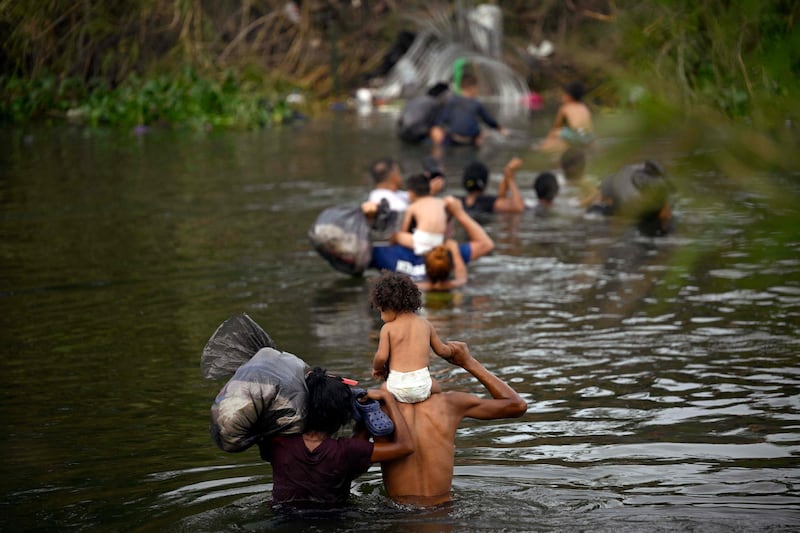The Biden administration is ending its use of Title 42, a sweeping coronavirus-era rule that had allowed officials to quickly turn away hundreds of thousands of migrants seeking asylum at the US-Mexico border.
The lifting of the public health order has motivated thousands to head to the border. The policy, which had been in place since March 2020, expires at the end of Thursday.
In El Paso, a border town in Texas, dozens of migrants, the majority of them young people from Venezuela, have been sleeping on the street beside the Sacred Heart Church, with dozens of others including women and children sheltered inside.
El Paso and other cities in Texas have declared a state of emergency as thousands more people were waiting in Juarez, the Mexican city on the other side of the border, hoping to cross into the US.
Dhean, 29, from Venezuela says he arrived three days ago after a 12-month journey that took him through Colombia, Chile, Peru and Mexico, mostly on foot.
When he arrived at the US-Mexico border, he jumped the fence, he says.

“I would rather live here illegally than stay in Venezuela, where the currency is worth nothing and there’s no work,” he says.
News regarding changes in policy mattered little in his decision to come to the US, he adds.
“Nothing matters to me if I don’t work,” Dhean tells The National before displaying a picture of his daughter, aged seven, on a cracked phone.
Immigration authorities and volunteers this week handed out flyers urging migrants who had entered the US without documents to turn themselves in at a nearby centre for processing.
Many were given parole documents or notices to appear in court.
El Paso officials on Thursday said the operation was intended to reduce the number of migrants sleeping on the streets.
Two vacant schools and one community centre with a 4,400-person capacity have been prepared to serve as temporary shelters.

“Right now, it’s hard to tell how many will come,” Mario D’Agostino, a deputy manager in El Paso, says during a media tour of the centre.
“Many numbers have floated around but I think we should expect close to 30,000 people to come through.”
About 24,000 American law enforcement officers were stationed along the sprawling 3,140km border with Mexico to deal with the surge, along with 1,500 US troops.
As many as 1,000 asylum officers are also expected to conduct initial screenings.
The development comes at a critical time in US politics, as President Joe Biden is seeking a second term in office.
The Democrat campaigned on a platform of being more welcoming towards migrants, many of whom are fleeing gang violence, poverty and the effects of climate change.
But amid unprecedented migration from Latin America, Mr Biden’s administration has struggled to manage the numbers arriving at the border, while also protecting migrants’ right to seek asylum.
Immigration has become a key political issue, with Mr Biden’s Republican rivals accusing him of having an “open border” policy.
"It’s important to have a credible immigration system that has the vast majority of immigration occurring legally," says James Massa, head of NumbersUSA, an anti-immigration advocacy group.
"What’s occurring right now is that two thirds of the immigration in the United States has been illegal - it’s wildly out of control."
The Biden administration insists the border is not open and will not be open after Title 42 expires.
Title 42 was first used by the administration of Donald Trump, when Covid-19 hit the US, to stem the spread of the virus.
But Mr Biden has continued to use the measure to control the numbers at the border, even as most other pandemic restrictions have been lifted.
“Tomorrow is going to be a day of infamy,” Mr Trump, who has made restricting immigration a signature policy, said in a town hall on Wednesday.
“You're going to have tens of thousands of people pouring into our country. You're going to have millions of people pouring into our country right now at a level that nobody's ever seen before.”
Under Title 42, which has been widely criticised by migrant advocates and progressives as a flagrant breach of US and international laws, border officials can quickly expel migrants at the border without processing their asylum claims.
The measure was used more than 2.8 million times.
Under the new rules, the US will revert to using Title 8, a strict asylum policy that will make it harder for migrants to file claims, while expediting initial screening interviews and deportations.
Migrants who cross the southern border without authorisation will be disqualified from asylum unless they can prove they previously sought protection in a third country.
This would make most nationalities, with the exception of Mexicans, would be ineligible for asylum.

Migrants must insteadarrive at the border after securing an appointment using a smartphone app.
Unlike Title 42 expulsions, which had no paper trail, removals under Title 8 include five-year bans on entering the US.
However, it remained unclear on Thursday how many migrants were aware of the new policies, or how they would apply to them.
Many thought that the lifting of Title 42 meant they could cross into the US.
Paolo, 21, also from Venezuela, arrived four days ago after 10 months on the road, which included begging on the streets for money and being attacked by Mexican gangsters.
He was travelling with his older brother, who is in US detention. Paulo is now sleeping on the street.
“I have no money and no resources to stay in a hotel,” he says with a raspy voice.
He has a throat infection and cannot afford a doctor or medicine, he says.
“I came here because I want to own a car and open my own business, a supermarket or something like that.”
Last month, the Department of Homeland Security said it would open several regional processing centres, starting with Colombia and Guatemala, where migrants could apply to enter the US.
The Biden administration has also said it would accept 30,000 people from Haiti, Cuba, Venezuela and Nicaragua every month under a programme called humanitarian parole.
But to qualify, applicants must secure a US-based sponsor and arrive in the country by plane.
All those arriving at the border without appointments will be sent back to Mexico or to their home countries.
The new regulations have already been met with criticism. They are also expected to be challenged in federal court.
The administration's new asylum rule "would curtail decades-old rights for asylum seekers coming to the United States", says Lee Williams, chief programmes officer at Lutheran Immigration and Refugee Service, a resettlement agency.
"It's also happening at a time when people are uprooted in unprecedented levels here in the Americas, as well as around the world, for reasons of violence, persecution, poverty and climate disaster.
"And from a moral standpoint, it contradicts with what the United States stands for as the world's humanitarian leader."







